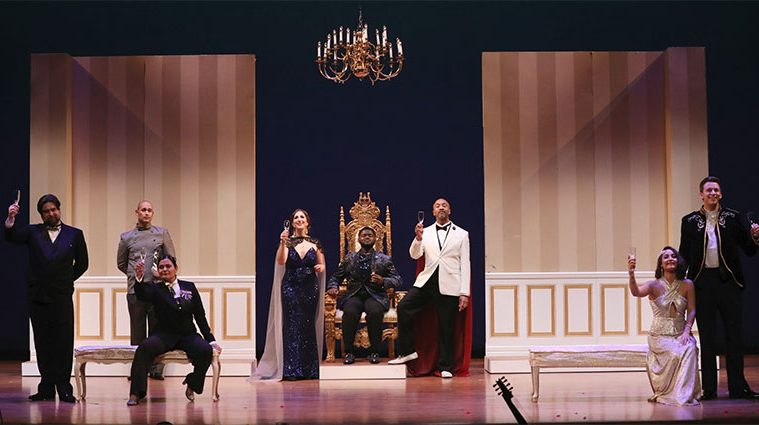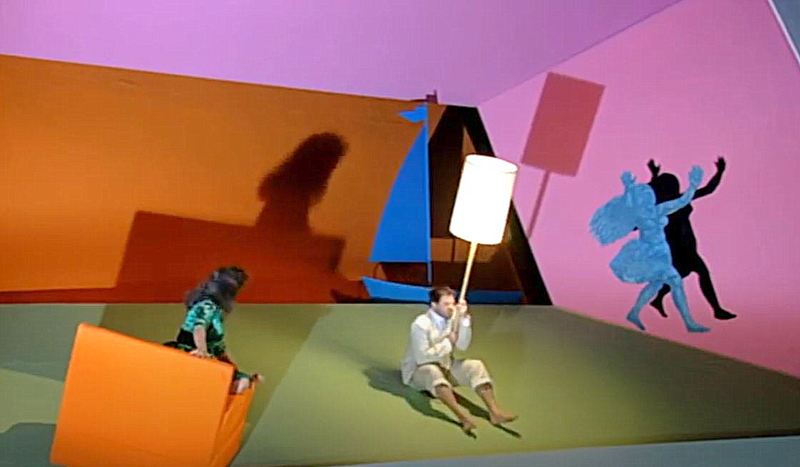Late in 1710 Georg Friedrich Händel arrived in London. A few months later, on 24 February 1711, his opera Rinaldo had its premiere, one day before his 26th birthday. It was a great success, he decided to stay in England, dropped the umlaut in his name and became a naturalised Englishman in 1727,
Here are two portraits of Handel, left circa 1710, right around 1726
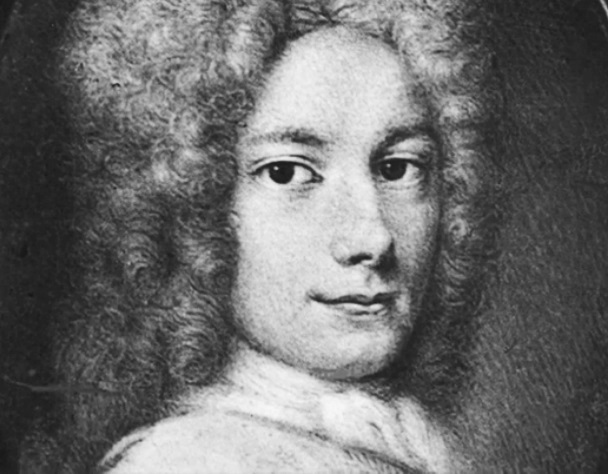
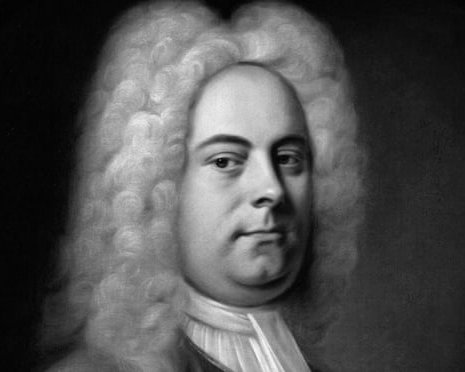
I got interested in Handel’s operas, when I was writing a blog about the only opera written by Domenico Scarlatti in 1703, An opera and some history. The history part is about Roman emperor Nero and his mistress Poppaea. History was a popular subject for operas in those days and a few years later Handel wrote his first major opera Agrippina (Nero’s mother). Premiere was in December 1709 in Venice, it was very successful and established the international reputation of 24 year old Handel. Many YouTube recordings exist, here is my favourite (click on the image to watch the recording).
Rinaldo also has a historical background, the First Crusade (1096-1099) The objective of this religious war was the recovery of the Holy Land from Islamic rule. In 1591 the Italian poet Torquato Tasso wrote an epic and romantic poem Gerusalemme liberata about the liberation of Jerusalem. It is epic, containing 1917 stanzas of 8 lines each. And also romantic, the historical background is mixed with several love stories.
The story of Rinaldo and Armida is the most famous one. Rinaldo is a handsome brave crusader knight and Armida a powerful witch, trying to destroy the Christian army. When she meets a sleeping Rinaldo and wants to kill him, she falls in love with the young man and absconds him to her magical island. Rinaldo becomes her willing prisoner and falls in love with her as well. The army sends two friends, Carlo and Ubaldo, to remind him of his duty. Finally they convince Rinaldo to abandon Armida and come back to the war.
Not surprisingly it became a favourite subject for artists. The left painting shows Armida, dagger in her hand, falling in love. The middle one shows a lovesick Rinaldo with Armida on her island and in the right painting the two soldiers have convinced Rinaldo to come back, the boat is waiting already..
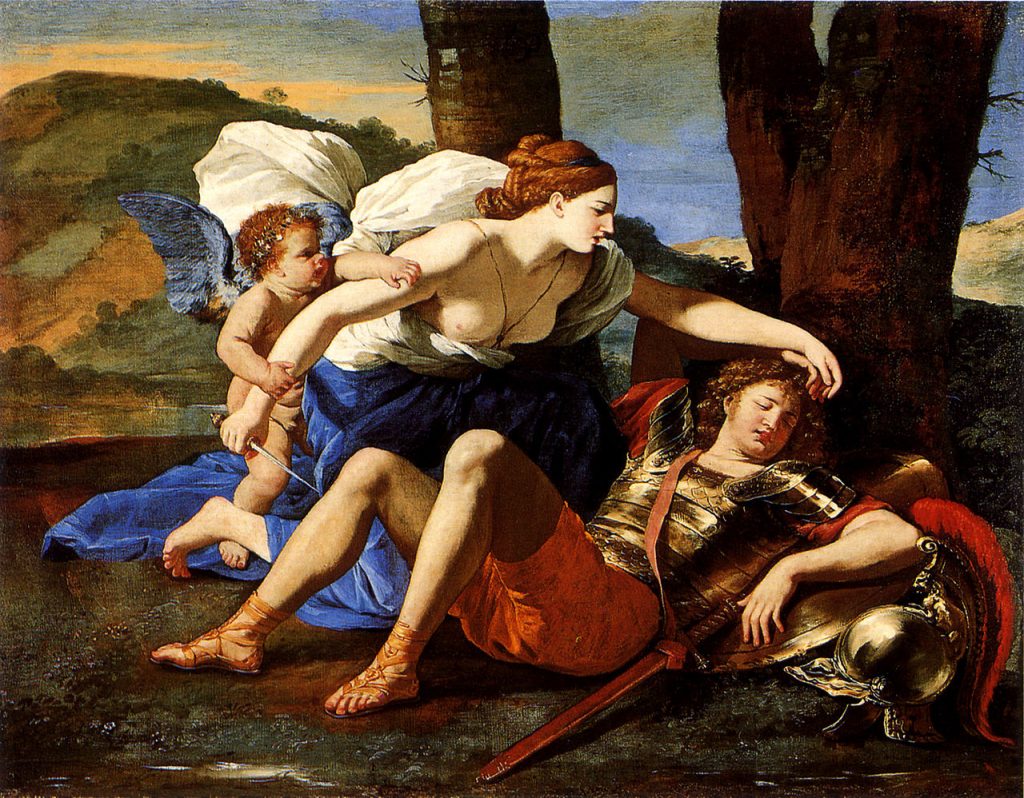
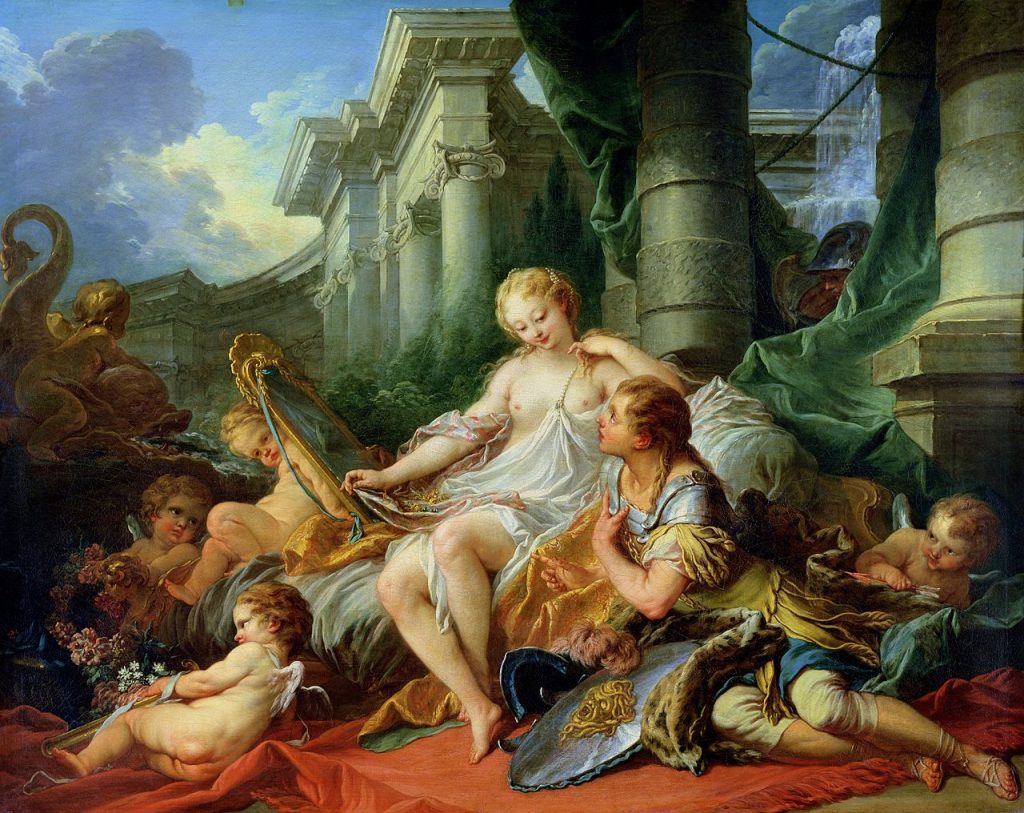
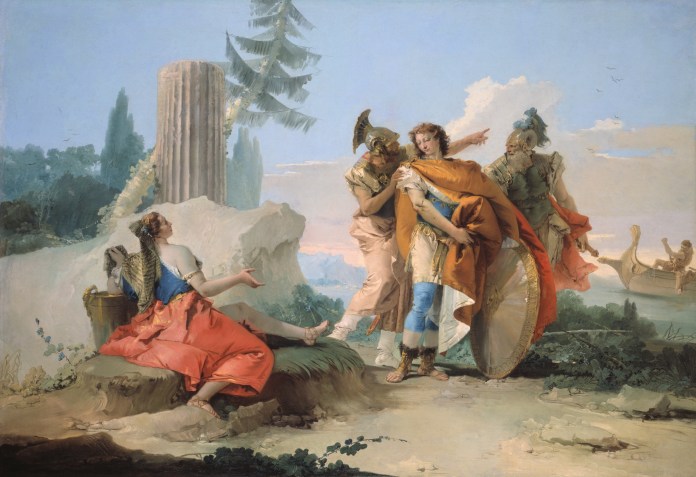
If you think that this introduction will make the opera (written in Italian) easier to understand, you are wrong. The story is tweaked completely. Yes, Goffredo is the leader of the Christian army and Rinaldo is the heroic warrior. But the opera gives Goffredo a daughter, Almirena, who will become Rinaldo’s bride after the war is won. And the witch Armida is the queen of Damascus in a love relationship with Argante, the king of Jerusalem. Here is a synopsis of the opera , taken from the very informative website opera-arias.com.
ACT I
The Christian army, led by Goffredo, is besieging the city of Jerusalem. If the city is taken, then the Christian warrior Rinaldo will be free to marry Goffredo’s daughter Almirena.
In an audience with Goffredo, Argante, the king of Jerusalem, is granted a three-day halt to hostilities. The sorceress Armida, queen of Damascus, descends from the skies and tells her lover Argante that their only hope of victory is the destruction of Rinaldo.
As Rinaldo and Almirena express their love for each other, Armida snatches Almirena away. Goffredo and his brother Eustazio discover the distraught Rinaldo. Eustazio suggests seeking the help of a Christian sorcerer who lives in a cave at the foot of a mountain.
ACT II
Goffredo, Eustazio and Rinaldo are wandering the seashore searching for the sorcerer when a spirit lures Rinaldo on board a ship by claiming to be sent by Almirena.
In a garden of Armida’s palace garden, Argante reveals his love for Almirena and offers to help her, but she repulses him.
When Rinaldo arrives, Armida’s initial triumph over him turns to love, but she is rejected. Armida transforms herself into the guise of Almirena, but Rinaldo again rejects her, fleeing when he discovers her trickery.
Armida again disguises herself as Almirena, but this time Argante enters and inadvertently reveals his feeIings for Almirena. Armida is outraged and swears revenge.
ACT III
Goffredo and Eustazio approach the mountain with Armida’s palace at its summit and the sorcerer’s cave at its foot. The sorcerer tells them that Almirena and Rinaldo are held by Armida, and the two warriors set off with two magic wands as protection.
Armida is about to stab Almirena, but Rinaldo rushes to protect her. Goffredo and Eustazio enter and with their wands transform the enchanted garden into a desert. Armida disappears. Argante attempts to rally his generals, and he and Armida are reconciled.
Battle commences, the Christians prevail and the two lovers are reunited. Argante and Armida are captured and, realizing the error of their ways, embrace the Christian faith.
You will agree that this “strange” plot has no resemblance to Tasso’s story of Rinaldo and Armida. Actually this plot was written by Aaron Hill, at that time the manager of the Queen’s Theatre in Hay Market, He was of the same age as Handel and wanted a “hit” for his theatre. Italian opera was becoming popular in London, famous Italian singers were available and his theatre could provide spectacular effects. Giacomo Rossi translated the libretto in Italian and Handel wrote the music. Rinaldo was the result. . All this within a couple of months (or even weeks, although that may be anecdotal) !
A copy of the original Rinaldo “booklet” still exists and is fascinating reading. It contains the text of the opera, both in Italian and in English and has a foreword written by Hill. Here is the foreword. Notice how Hill defends the changes in Tasso’s original story and argues that an opera should give equal pleasure to both senses.
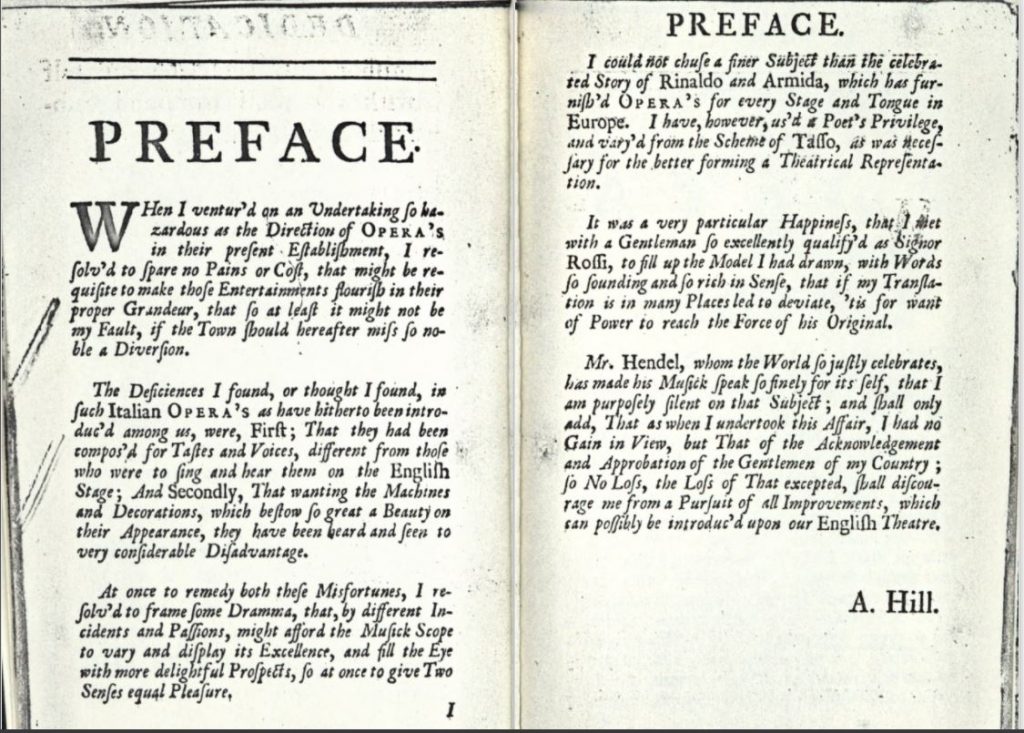
Here is the cast of the first performance. The roles of Rinaldo , Eustazio were sung by castrati, while the part of Goffredo was sung by a female contralto (in travesty). All singers were Italian, the two castrati were so famous that they had nicknames, Niccolini and Valentini. The two sopranos were also prima donnas (and bitter rivals).
| Name | Role | Voice | Singer |
|---|---|---|---|
| Goffredo | leader of the First Crusade | contralto (en travesti) | Francesca Vanini-Boschi |
| Rinaldo | a nobleman of the House of Este | alto castrato | Nicolò Grimaldi (“Nicolini”) |
| Almirena | daughter of Goffredo | soprano | Isabella Girardeau |
| Eustazio | brother to Goffredo | alto castrato | Valentino Urbani (“Valentini”) |
| Argante | Saracen king of Jerusalem | bass | Giuseppe Boschi |
| Armida | Queen of Damascus, Argante’s mistress | soprano | Elisabetta Pilotti-Schiavonetti |
| Mago | a Christian magician | alto castrato | Giuseppe Cassani |
It must have been a spectacular performance. The libretto contains very detailed stage instructions. Here are a few from ACT III, where Goffredo and Eustazio arrive at the cave of the Mago.
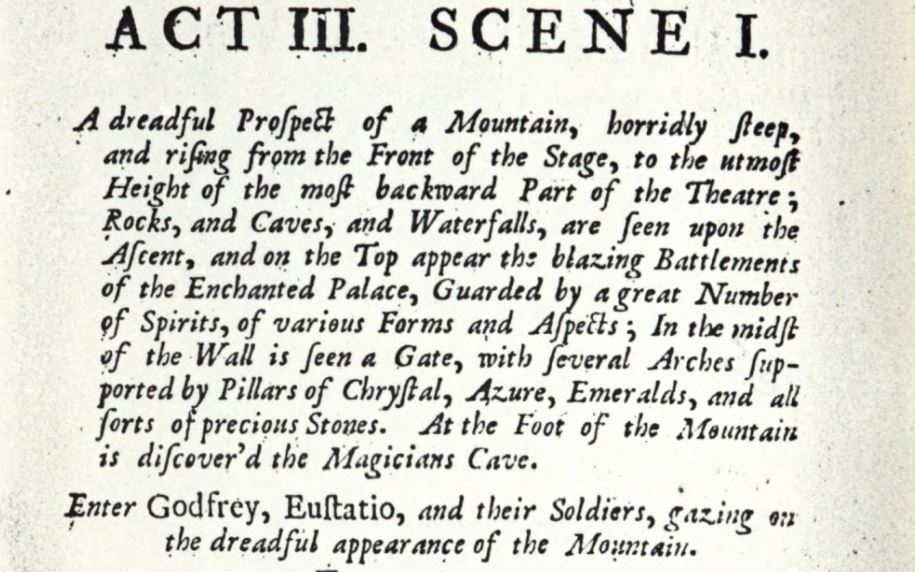
Notice in how much detail the stage is described. A mountain rising from the front of the stage to the utmost height of the most backward part of the stage. Rocks , caves and waterfalls. A castle on top,” guarded by a great number of spirits“. The audience must have been gasping in awe.
The Mago warns them that they can not attack the castle without his help, but still they try. And fail. Many soldiers are swallowed by the mountain, “with thunder, lightning and amazing noises“.
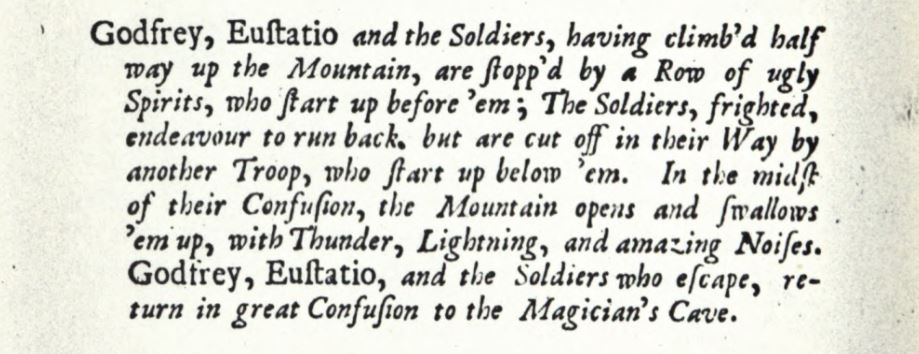
The Mago gives them magical wands and that helps. When they touch the gate of the castle, the whole mountain disappears and Goffredo and Eustazio find them selves clinging to a rock in the middle of a sea.
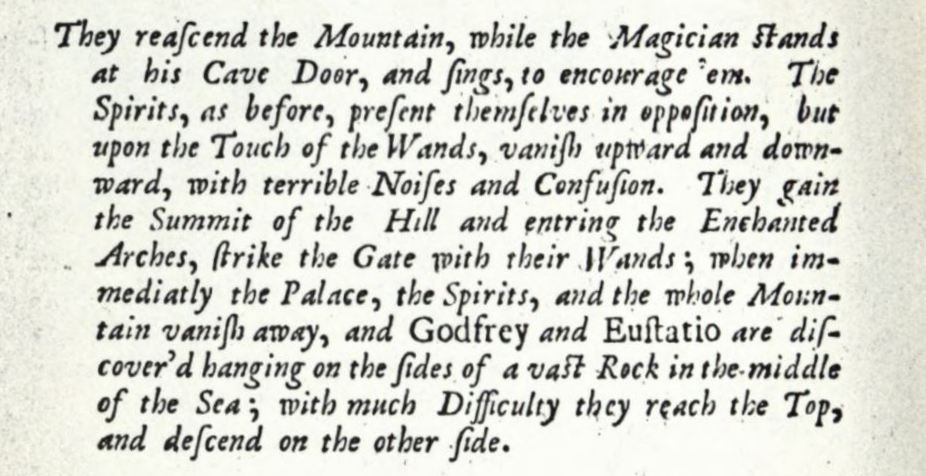
No wonder that the opera was a success. In the period until 1711-1717 it was performed 47 times, more than any other opera in the Queen’s theatre, Handel revised the opera in 1731, it was also performed abroad a few times but soon it went into oblivion. Only more than 200 year later, in 1954, there was a performance during a Handel festival in Germany. More about the performance history here.
On YouTube I have found only three complete video recordings of Rinaldo. Here is a short description of them.
The first one is a performance in Prague, directed by Václav Luks in 2009. Here is a screenshot , click on it to watch the opera. For me the least attractive of the three that I have seen. In the first place the cast. Of course there are no more castrati nowadays, but the parts of Rinaldo and Eustazio are sung here by mezzo-sopranos instead of by countertenors. Goffredo too is sung by a mezzo-soprano and not by a contralto. The mise-en-scène is very static, the singers face the audience almost permanently, only move a lot their hands and fingers. Here is a (rather negative) review. The YouTube has French subtitles, which makes it easier to follow the plot.
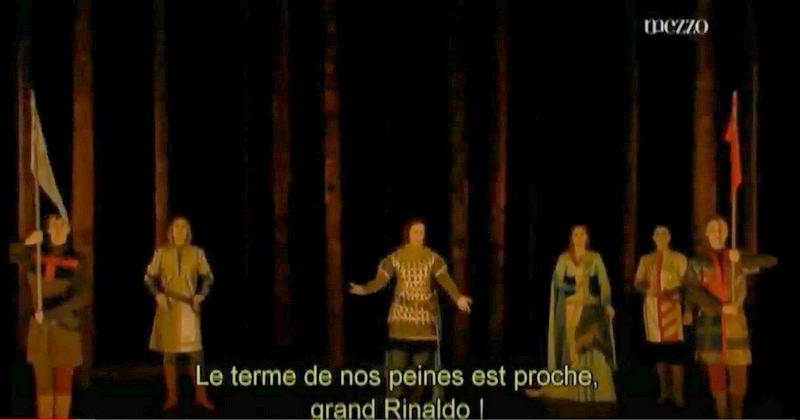
In 1985 Pier Luigi Pizzi directed the 1731 version of Rinaldo which became quite popular and was repeated several times. Here is a screenshot from the 2012 performance in Ravenna, click on the image to watch the opera. The role of Eustazio has been deleted, Goffredo is sung by a tenor and Rinaldo by a mezzo-soprano. The screenshot shows Goffredo, Almirena and Rinaldo. For reasons unclear to me, Almirena and Rinaldo are dressed almost identically. I found the mise-en-scene weird, the singers don’t walk around themselves but are moved by invisible helpers while seated on a horse, sitting in a boat or standing on a platform. No subtitles. Here is a critical review.
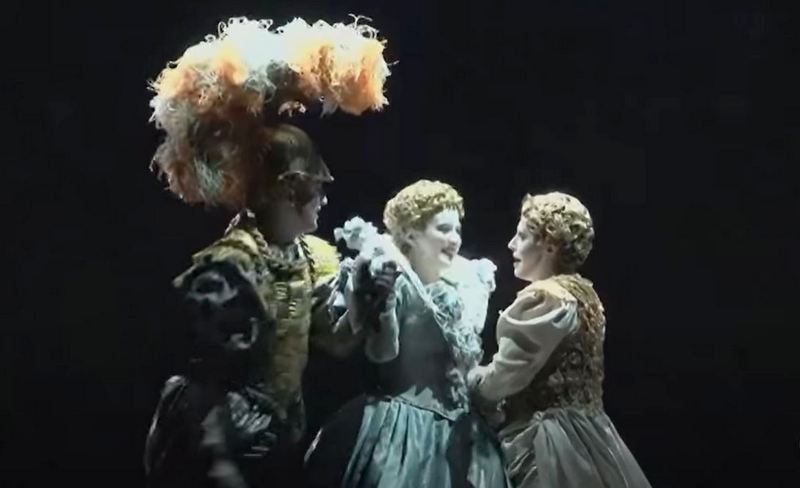
The first time I listened to Rinaldo, was on YouTube, an audio recording of a 2002 performance directed by René Jacobs. Very positive reviews. There is another audio recording , 1999, directed by Christopher Hogwood. Both still available as audio-CD.
I got interested how the opera was staged and found a video recording of a 2001 performance in Munich, by the Bayerische Staatsoper. It was on YouTube for some time, then it disappeared, probably because of copyright issues. Now it is back again, but for how long?
What an absurd, crazy mise-en-scène, was my first reaction. But I have changed my opinion, after reading the libretto and watching the other recordings. Yes, It is a parody of the original plot. But the plot deserves that. Example: in Act III, after the crusaders have won the battle of Jerusalem, Argante and Armida unexpectedly decide to become Christian. That Goffredo often changes his dress into a clerical robe fits into an implausible plot. There are many slapstick elements in this version, making Rinaldo a pleasure for the ears AND the eyes (as was Aaron Hill’s origina intention)
Here are screenshots from the three YouTube videos, click to watch. Subtitles in English,
Act I From left to right Rinaldo, Goffredo and Eustazio (all three countertenors) and Almirena as a cheerleader (!), encouraging Rinaldo to fight
Act II In her magic castle Armida tries to seduce Rinaldo. She tries twice to take the form of Almirena. The right wall, with a cardboard figure and a gap in the wall is used in a really brilliant way to confuse Rinaldo.
Act III The Christian magician (countertenor, cast as a voodoo priest) has given Goffredo and Eustazio magic wands to enter the enchanted castle.
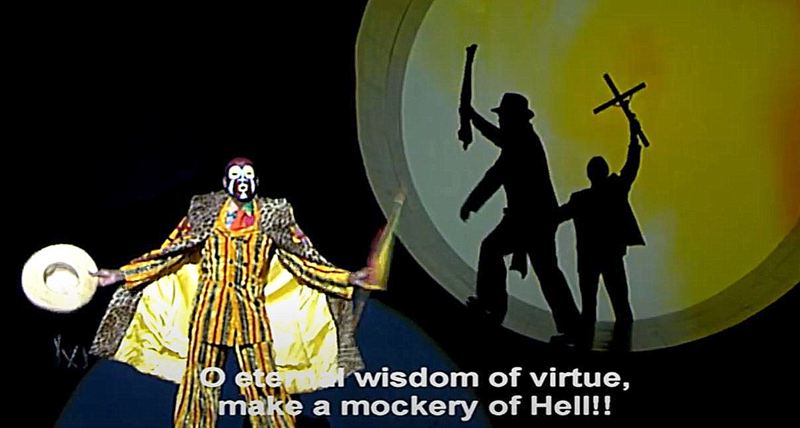
In Act III the battle takes place between the two armies. In Hill’s stage directions there are soldiers and Handel wrote martial music to be played during the fighting. The solution found in this modern performance is inventive and ingenious, a real pleasure for the eyes.
Not surprisingly this performance received mixed reviews .. You either love or hate this “camp” version. It is clear that I love it 😉 .
Actually I am not a real opera fan. Many of the famous operas (by Verdi, Wagner, Puccini etc) do not appeal to me. But I love Baroque operas (and of course Mozart), Handel was a prolific composer, he wrote 42 operas, I have listened to only a few of them. So there still will be a lot of beautiful music to enjoy!

